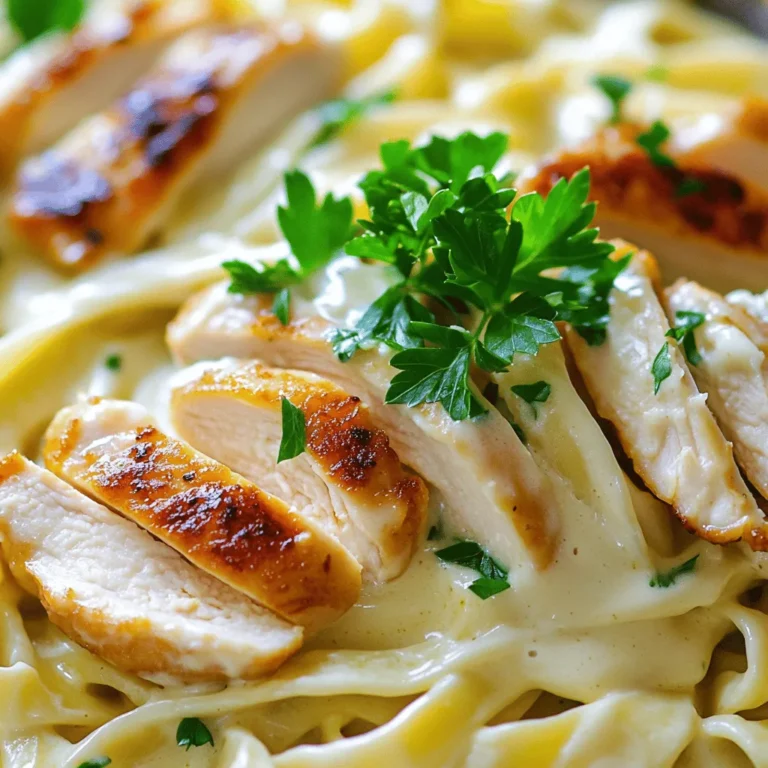Creamy Coconut Chickpea Curry Flavorful and Easy Meal
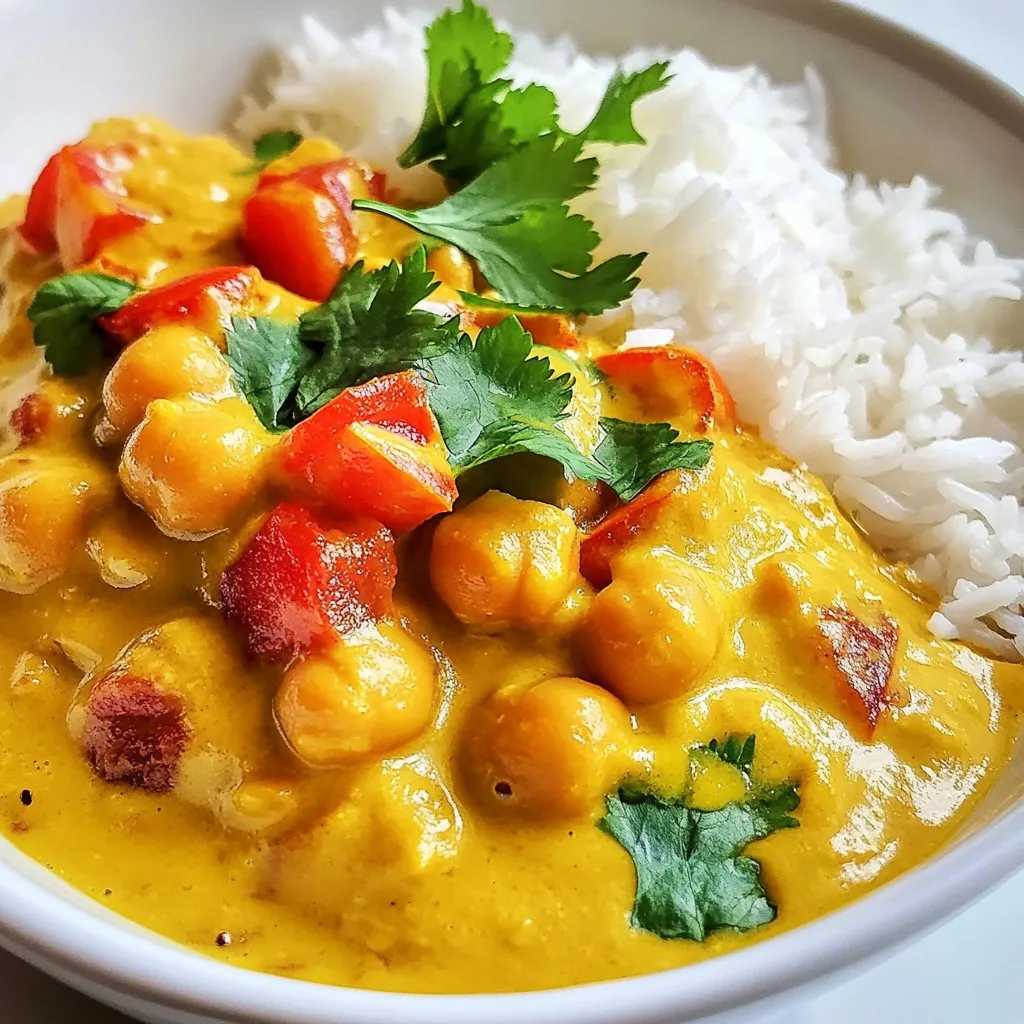
Looking for a quick, tasty meal to impress? Try my Creamy Coconut Chickpea Curry! It’s packed with flavor and uses simple ingredients you might already have. Chickpeas, creamy coconut milk, and a mix of warm spices come together for a satisfying dish. Perfect for busy weeknights or meal prep, this curry is easy to customize. Let’s dive into how to make this delicious and creamy dish!
Why I Love This Recipe
- Quick and Easy: This recipe takes only 35 minutes from start to finish, making it perfect for busy weeknights.
- Flavorful and Aromatic: The combination of spices and coconut milk creates a rich, fragrant dish that delights the senses.
- Nutritious: Chickpeas provide protein and fiber, while coconut milk adds healthy fats, making this a well-rounded meal.
- Versatile: This curry can be served with rice, quinoa, or even enjoyed on its own, adapting to your dietary preferences.
Ingredients
Main Ingredients
- 1 can (14 oz) chickpeas, drained and rinsed
- 1 can (14 oz) coconut milk
- 1 medium onion, finely chopped
- 2 cloves garlic, minced
- 1 tablespoon fresh ginger, grated
Chickpeas are the star of this dish. They bring protein and fiber. Coconut milk adds creaminess and a rich flavor. The onion, garlic, and ginger create a strong base for the dish. This mix gives the curry a warm and inviting aroma.
Spices and Seasonings
- 1 tablespoon curry powder
- 1 teaspoon ground cumin
- 1 teaspoon turmeric
- 1 teaspoon chili powder (adjust to taste)
Spices are key to a great curry. Curry powder adds the main flavor. Ground cumin gives a warm, earthy taste. Turmeric not only colors the dish but also adds health benefits. Chili powder adds heat, which you can control based on your taste.
Additions and Garnish
- 1 cup diced tomatoes (fresh or canned)
- 1 cup vegetable broth
- Fresh cilantro leaves, for garnish
- Salt and pepper, to taste
Diced tomatoes add acidity, balancing the creamy coconut. Vegetable broth enhances the depth of flavor. Fresh cilantro brings brightness and a fresh finish. Don’t forget to season with salt and pepper to bring out all the flavors!
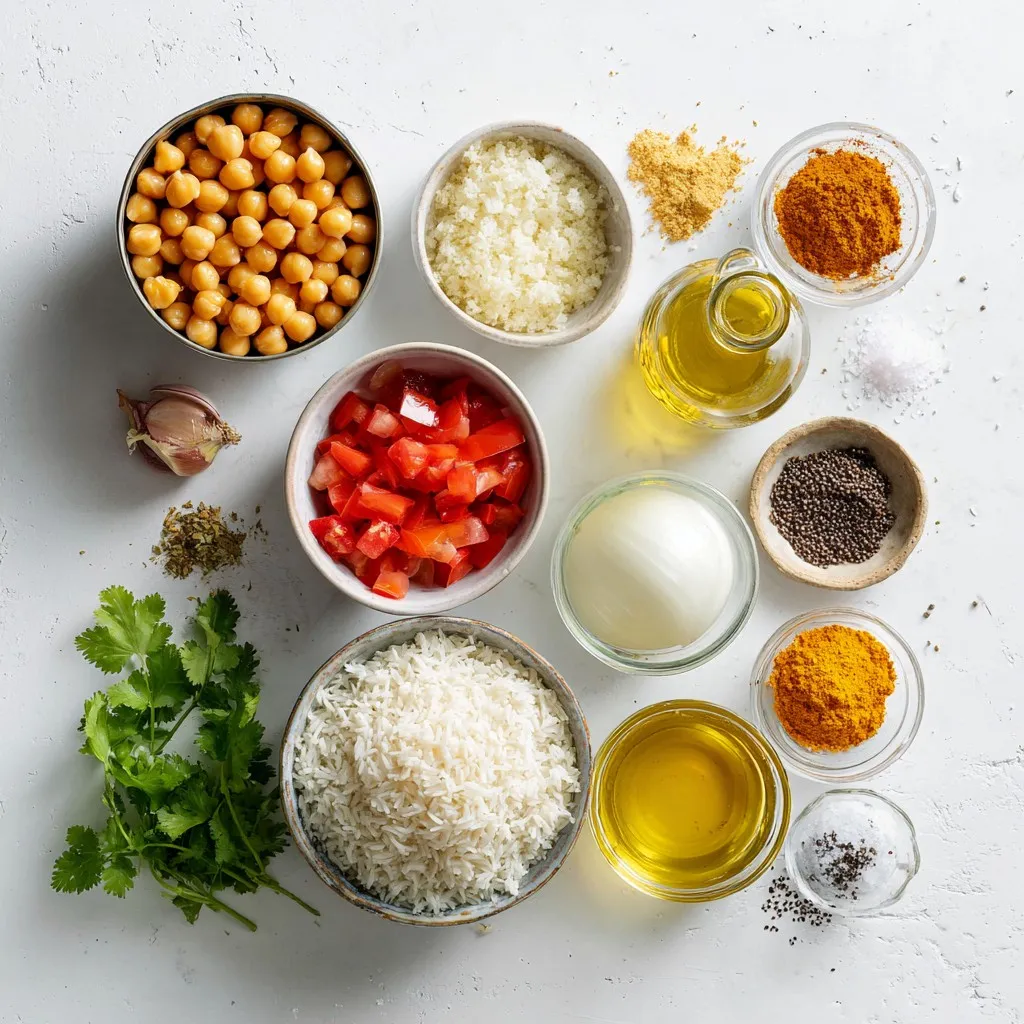
Step-by-Step Instructions
Preparing the Base
1. Heating olive oil: Start by pouring 2 tablespoons of olive oil into a large pan. Place it over medium heat. Allow the oil to warm for a few moments.
2. Sautéing onions: Once the oil is hot, add 1 medium onion, finely chopped. Sauté the onion for about 5 minutes, stirring often. It should become soft and turn translucent.
Adding Aromatics and Spices
1. Incorporating garlic and ginger: Next, stir in 2 cloves of minced garlic and 1 tablespoon of grated ginger. Cook this mixture for about 1 minute. You want the garlic to be lightly golden and aromatic.
2. Cooking the spice mixture: Now, add 1 tablespoon of curry powder, 1 teaspoon of ground cumin, 1 teaspoon of turmeric, and 1 teaspoon of chili powder. Stir the spices constantly for 1 minute. This helps release their fragrant flavors.
Combining and Simmering
1. Mixing in tomatoes and chickpeas: Add 1 cup of diced tomatoes to the pan. Stir them in and let the mixture cook for 3-4 minutes. The sauce will start to thicken.
2. Simmering for flavor melding: Pour in 1 can of drained chickpeas, 1 can of coconut milk, and 1 cup of vegetable broth. Stir everything well. Bring the curry to a gentle simmer and cook uncovered for about 15-20 minutes. This helps all the flavors blend together nicely.
Tips & Tricks
Enhancing Flavor
To boost the flavor of your curry, adjust spices to your taste. Start with the curry powder. If you like it spicier, add more chili powder. You can also add a squeeze of lime juice. This gives the dish a fresh taste and brightens the flavors.
Perfecting Consistency
If you want a thicker curry, let it simmer longer. The sauce will reduce and become rich. For a creamier texture, add more coconut milk. This will make the curry smooth and luscious.
Serving Suggestions
Serve your creamy coconut chickpea curry with fluffy rice or quinoa. These grains soak up the sauce nicely. For garnishes, fresh cilantro is a must. You can also add lime wedges for an extra zing.
Pro Tips
- Use Fresh Ingredients: Opt for fresh herbs and spices whenever possible to enhance the flavor profile of your curry.
- Adjust Spice Levels: Feel free to modify the amount of chili powder to suit your heat preference; you can always start with less and add more.
- Let It Rest: Allow the curry to rest for a few minutes after cooking to let the flavors settle before serving.
- Experiment with Add-Ins: Consider adding vegetables like spinach, bell peppers, or sweet potatoes for added nutrition and texture.
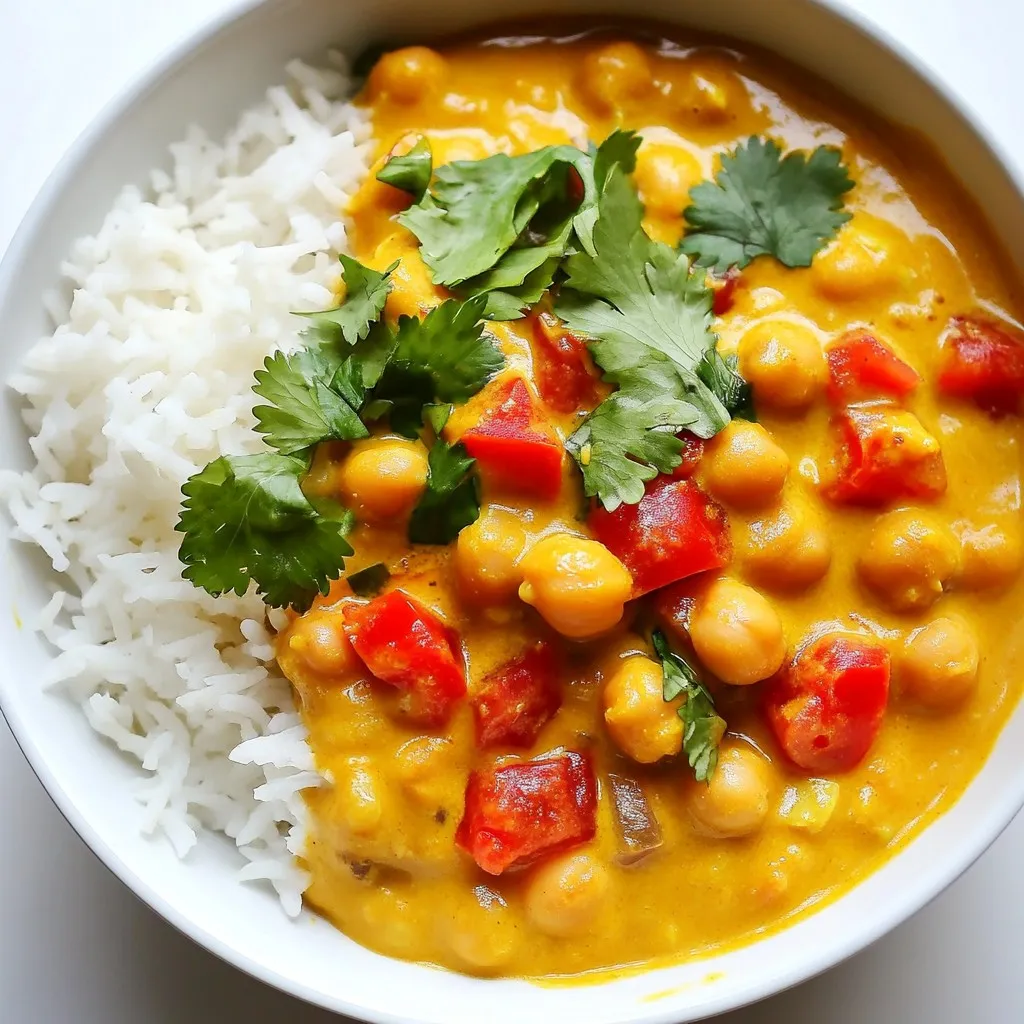
Variations
Ingredient Swaps
You can easily change the legumes in this recipe. Instead of chickpeas, try black beans or lentils. Each of these options adds a unique flavor while keeping the dish hearty. You can also add fresh vegetables like spinach or bell peppers. Both options brighten the dish and increase its nutrition. Just toss them in during the simmering step for best results.
Dietary Adjustments
This curry is naturally vegan and gluten-free. If you want to keep it low-calorie, you can use light coconut milk. It still tastes creamy without the extra fat. You can also reduce the amount of oil or serve it with cauliflower rice instead of regular rice. These swaps help you enjoy a delicious meal while keeping your diet in check.
Alternative Cooking Methods
You can use an Instant Pot for a quicker meal. Just sauté the onions and spices, then add your other ingredients. Set it to high pressure for about 10 minutes. If you prefer a slow cooker, combine all ingredients and cook on low for 6-8 hours. This method deepens the flavors. For a one-pan option, you can cook everything in a large skillet. Just make sure to cover it while it simmers for even cooking.
Storage Info
Storing Leftovers
- Refrigeration tips: Allow the curry to cool down first. Transfer it to an airtight container. It will stay fresh in the fridge for about 3 to 5 days.
- Freezing instructions: For longer storage, place the curry in a freezer-safe container. It can last up to 3 months in the freezer. Make sure to leave some space for expansion.
Reheating Guidelines
- Best methods for reheating the curry: The microwave works well for quick reheating. Alternatively, heat it on the stove over low heat for even warming.
- How to maintain flavor and texture: Add a splash of water or vegetable broth while reheating. This helps keep the curry creamy and prevents it from drying out.
Shelf Life
- How long the curry lasts in the fridge or freezer: In the fridge, it lasts up to 5 days. In the freezer, it can last up to 3 months.
- Signs of spoilage: Check for an off smell, mold, or changes in color. If you see any signs, it’s best to discard the curry.
FAQs
Can I make this curry in advance?
Yes, you can make this curry ahead of time. It saves time on busy days. Just prepare the curry as directed and let it cool. Store it in an airtight container in the fridge for up to three days. When ready to eat, reheat it on the stove. This curry often tastes even better the next day as the flavors blend.
What can I serve with Creamy Coconut Chickpea Curry?
You have many great options for sides. Here are some ideas:
- Cooked rice (white or brown)
- Quinoa
- Naan bread
- Fresh salad
- Steamed vegetables
Each of these sides pairs well with the rich flavors of the curry.
Is this recipe suitable for kids?
Yes, this recipe can be kid-friendly with some tweaks. Reduce the chili powder for less heat. You can also use mild curry powder. Adding some extra coconut milk can make it creamier and smoother. Serve with rice, which kids often love. This makes the meal more appealing for young eaters.
This blog post covered the main ingredients, instructions, and tips for making Creamy Coconut Chickpea Curry. You learned about essential ingredients like chickpeas and coconut milk, along with spices that add depth to the dish. I shared techniques to enhance flavor and tips for storage, ensuring your meal lasts.
Remember, cooking is about creativity and enjoyment. Feel free to experiment with different ingredients and methods. Enjoy making this curry and sharing it with other
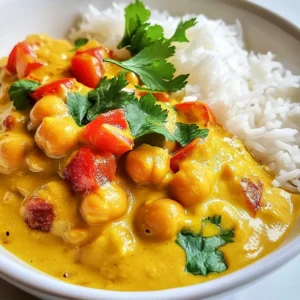
Creamy Coconut Chickpea Curry
Ingredients
- 1 can chickpeas, drained and rinsed (14 oz)
- 1 can coconut milk (14 oz)
- 1 medium onion, finely chopped
- 2 cloves garlic, minced
- 1 tablespoon fresh ginger, grated
- 1 tablespoon curry powder
- 1 teaspoon ground cumin
- 1 teaspoon turmeric
- 1 teaspoon chili powder (adjust to taste)
- 1 cup diced tomatoes (fresh or canned)
- 1 cup vegetable broth
- 2 tablespoons olive oil
- to taste salt and pepper
- for garnish fresh cilantro leaves
- for serving cooked rice or quinoa
Instructions
- In a large pan, pour in the olive oil and warm it over medium heat. Once hot, add the finely chopped onion and sauté it for about 5 minutes, or until it becomes translucent and soft.
- Next, stir in the minced garlic and grated ginger. Cook for an additional minute, stirring occasionally, until the mixture is aromatic and the garlic is lightly golden.
- Add the curry powder, ground cumin, turmeric, and chili powder into the pan. Stir constantly for about 1 minute to awaken the spices and enhance the fragrances.
- Mix in the diced tomatoes, allowing them to cook for another 3-4 minutes. The liquid should begin to thicken slightly, creating a rich sauce.
- Pour in the drained chickpeas, coconut milk, and vegetable broth. Stir everything together until thoroughly combined. Bring the mixture to a gentle simmer, stirring occasionally.
- Lower the heat to a gentle simmer and let the curry cook uncovered for about 15-20 minutes. This allows the flavors to meld beautifully, and the sauce to thicken further.
- Taste your curry and season it with salt and pepper as needed, adjusting spices to match your preference.
- Plate the hot curry over a bed of fluffy cooked rice or quinoa. Garnish generously with fresh cilantro leaves for a vibrant finish.



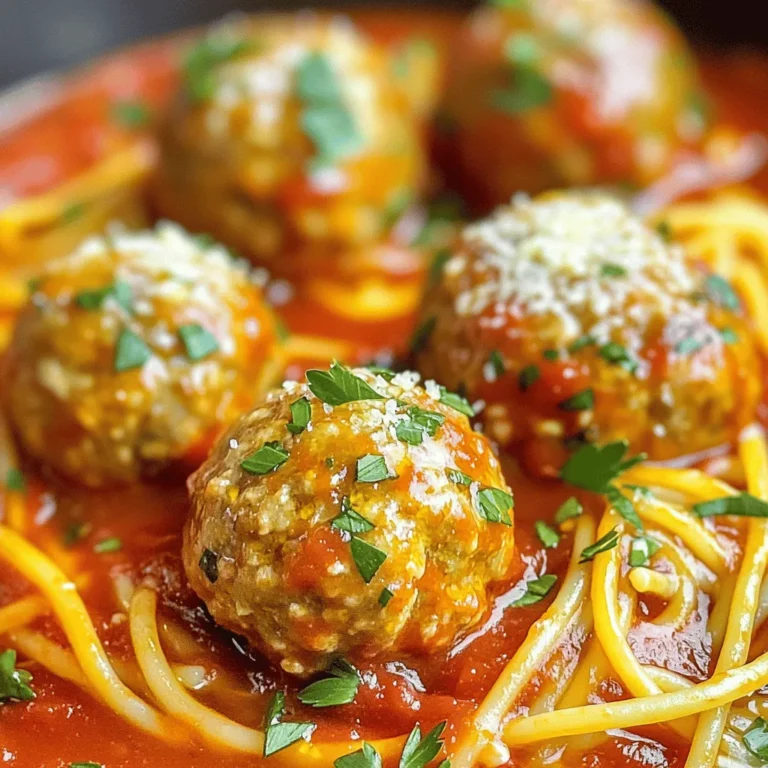
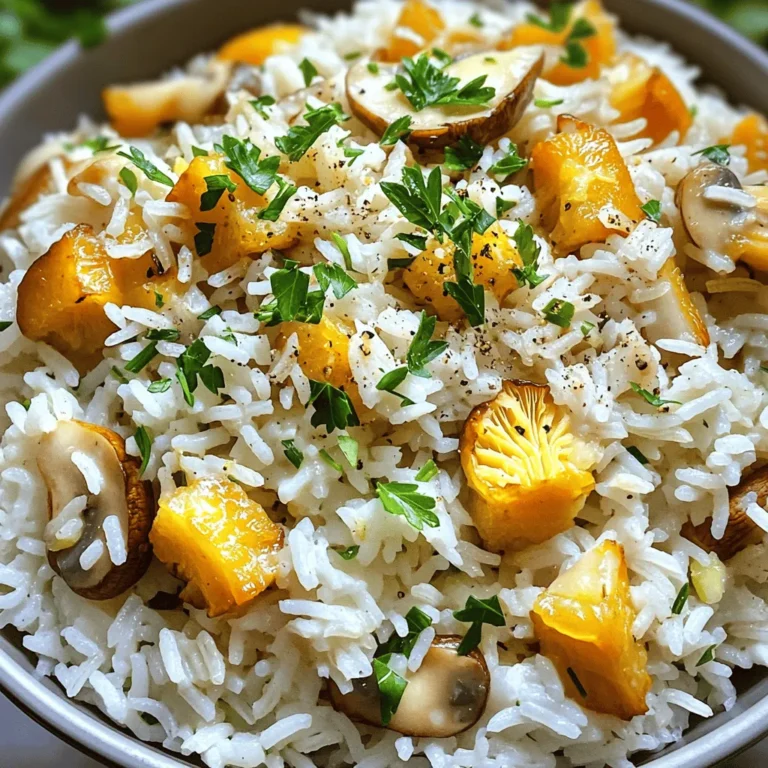
![- 2 boneless, skinless chicken breasts, sliced into thin strips - 2 tablespoons honey - 4 cloves garlic, minced - 2 tablespoons low-sodium soy sauce - 1 tablespoon sesame oil - 1 red bell pepper, thinly sliced - 1 cup broccoli florets - 1 cup snap peas - 1 carrot, julienned - 2 tablespoons vegetable oil - Salt and pepper to taste I love using fresh chicken for this dish. It cooks well and tastes great. Honey adds a sweet touch, while garlic gives it a nice punch. You can pick any colorful veggies you like. I usually choose bell peppers, broccoli, and snap peas for their crunch. - Sesame seeds - Sliced green onions Garnishes make your meal pop! Sesame seeds add a nutty flavor. Green onions give a fresh, sharp taste. They make the dish look fancy, too. - Skillet or wok - Mixing bowl - Whisk A large skillet or wok is best for stir-frying. It helps cook everything quickly and evenly. You’ll also need a mixing bowl for the sauce. A whisk is handy to mix your sauce smoothly. For the full recipe and cooking instructions, check the [Full Recipe]. - How to prepare the sauce To make the sauce, grab a small mixing bowl. Add 2 tablespoons of honey and 4 minced garlic cloves. Pour in 2 tablespoons of low-sodium soy sauce and 1 tablespoon of sesame oil. Whisk these ingredients well until they blend smoothly. This sauce will be full of flavor! - How to season the chicken Take 2 sliced chicken breasts and place them in a bowl. Lightly sprinkle salt and pepper over the chicken. Toss it gently to coat every piece evenly. This step is key to making sure your chicken tastes great. - Cooking the chicken Heat a large skillet or wok over medium-high heat. Add 1 tablespoon of vegetable oil. Once the oil shimmers, add the seasoned chicken strips. Cook them for about 5-7 minutes. Look for a golden color and make sure they are cooked all the way through. Remove the chicken and set it aside on a plate. - Stir-frying the vegetables In the same skillet, add another tablespoon of vegetable oil. Throw in the sliced red bell pepper, 1 cup of broccoli florets, 1 cup of snap peas, and 1 julienned carrot. Stir-fry these vegetables for 3-4 minutes. You want them to stay vibrant and crisp-tender. - Combining and flavoring the dish Now, return the cooked chicken to the skillet. Pour the honey garlic sauce over everything. Stir it well to coat all the chicken and vegetables. Cook for an extra 2-3 minutes. This allows the sauce to thicken and stick to your meal. - How to garnish and serve Once done, take the skillet off the heat. Sprinkle sesame seeds and sliced green onions over the stir fry. This adds a nice crunch and fresh flavor. For an appealing look, serve it in shallow bowls on a bed of rice or noodles. Enjoy your tasty Honey Garlic Chicken Stir Fry! Check the Full Recipe for more details! For the best stir-fry, set your heat to medium-high. This helps to cook the chicken fast and keep it juicy. When cooking, work in batches if your pan is small. This way, the chicken won’t steam. To get crisp veggies, don’t overcrowd the pan. Just like the chicken, cook the veggies fast. Stir them often, about three to four minutes will do. Add some red pepper flakes for a spicy kick. You can also try fresh ginger for a nice zing. Balancing sweet and savory is key. If it’s too sweet, add a dash more soy sauce. Taste as you go to find the perfect mix. Serve your stir fry in shallow bowls. Place it on a bed of rice or noodles for a great look. Top with extra sesame seeds and sliced green onions. A lime wedge on the side adds color and flavor! {{image_4}} You can switch the chicken for other proteins. Tofu works great for a vegetarian dish. Just press and cube the tofu, then cook it like the chicken. Shrimp is another tasty option. It cooks fast and adds a nice flavor. Feel free to mix up the veggies. Bell peppers, zucchini, and green beans all taste amazing. Seasonal flavors add fun too! Use fresh corn in summer or squash in fall. These choices bring color and taste to your meal. You can change the sauce to fit your taste. If you want less sweetness, use less honey. To make it salty, add more soy sauce. Want some heat? Toss in red chili flakes or chopped peppers. This will spice up your stir fry and make it unique. To store your honey garlic chicken stir fry, cool it down first. Place the leftovers in an airtight container. This helps keep out air and moisture. I recommend using glass or BPA-free plastic containers. They are safe and durable. Make sure to refrigerate within two hours of cooking. This keeps the dish fresh and safe to eat. Yes, you can freeze honey garlic chicken stir fry! It freezes well and saves time for future meals. To freeze, use a freezer-safe container or a zip-top bag. Remove as much air as possible before sealing. For best results, eat it within three months. When you're ready to eat, thaw it in the fridge overnight. Reheat it in a skillet over medium heat until hot. This keeps the chicken and veggies tender. Leftovers will last about three to four days in the fridge. Always check for signs of spoilage before eating. If it smells off or has a strange color, it’s best to toss it. You'll want to avoid any food safety risks. Remember, good storage means enjoying your tasty meal later! To cut the sweetness, reduce the honey. Use one tablespoon instead of two. You can also add more soy sauce to balance the flavor. Adding a splash of rice vinegar or lime juice helps too. These add tang without making it too sweet. You can also use low-sugar honey or a sugar-free sweetener. Yes, you can prepare the chicken and veggies ahead of time. Slice the chicken and chop the vegetables. Store them in the fridge until you're ready to cook. You can also mix the sauce in advance. Just keep it in a sealed container. When you are ready to eat, cook it all together for a quick meal. Some good side dishes include: - Steamed rice - Fried rice - Noodles - Quinoa - A fresh green salad These sides add more texture and flavor to your meal. They also help soak up the tasty sauce. - Full Recipe: Detailed cooking instructions for easy reference. In this blog post, we explored the key ingredients and cooking steps for honey garlic chicken stir fry. We covered how to prepare the sauce, cook the chicken, and stir-fry the veggies. I shared useful tips on enhancing flavors and balancing taste. Plus, we discussed variations and storage methods for your leftovers. Cooking can be fun and rewarding. With these skills, you can create tasty meals. Enjoy trying new ingredients and discovering your favorites. Happy cooking!](https://dishtreats.com/wp-content/uploads/2025/07/ad7e2fa8-e610-4152-a96e-e496d4740468-768x768.webp)
![To make delicious spinach ricotta stuffed shells, gather these key ingredients: - 20 jumbo pasta shells - 2 cups fresh spinach, finely chopped - 1 cup creamy ricotta cheese - 1 cup shredded mozzarella cheese, divided - ½ cup grated Parmesan cheese - 1 large egg, lightly beaten - 2 cups marinara sauce, divided - 1 teaspoon garlic powder - 1 teaspoon onion powder - Salt and pepper, to taste - Fresh basil leaves, for garnish These ingredients create a rich and tasty filling. The spinach adds color and nutrition. The ricotta provides creaminess, while the mozzarella and Parmesan give a cheesy, savory flavor. While ricotta is the star, you can try other cheeses too. Here are some tasty options: - Cottage cheese: It’s similar to ricotta but a bit lighter. - Goat cheese: This adds a tangy flavor. - Cream cheese: It gives a rich, creamy texture. Feel free to mix and match! This lets you customize the taste to your liking. A good marinara sauce makes your dish shine. You can use store-bought or homemade. Here are some options: - Classic marinara: A simple, tomato-based sauce for a traditional taste. - Marinara with herbs: Look for added basil or oregano for extra flavor. - Spicy marinara: If you like heat, go for a sauce with red pepper flakes. You can find a perfect sauce that matches your style. The right sauce ties the whole dish together and makes it even more delicious. For the full recipe, check here: [Full Recipe]. Start by preheating your oven to 375°F (190°C). This heat will help cook the stuffed shells just right. Next, take a big pot and fill it with salted water. Bring the water to a boil. Once boiling, gently add the jumbo pasta shells. Cook them for 8-10 minutes until they are al dente. Be careful not to overcook them, or they will break. After cooking, drain the shells and let them cool for a bit. This step is vital for easy handling later. In a large bowl, mix the following ingredients for the filling: - 2 cups fresh spinach, finely chopped - 1 cup creamy ricotta cheese - ½ cup grated Parmesan cheese - 1 large egg, lightly beaten - 1 teaspoon garlic powder - 1 teaspoon onion powder - Salt and pepper, to taste Stir these ingredients until they blend well. The spinach should be evenly mixed with the cheeses and spices. This filling will give your shells a rich taste. Take a spoon and fill each jumbo shell with the spinach-ricotta mixture. Place the filled shells in a greased baking dish. Make sure they sit nicely side by side. After all shells are filled, pour half of the marinara sauce over them. This sauce keeps the shells moist and adds flavor. Next, sprinkle the remaining mozzarella cheese on top. Pour the rest of the marinara sauce over the shells. Cover the dish with aluminum foil to keep moisture in. Bake for 25 minutes. After that, remove the foil and bake for another 10-15 minutes. You want the cheese to be golden brown and bubbly. Let the shells cool a bit before serving. Garnish with fresh basil leaves for a pop of color and flavor. For the full recipe, check it out [Full Recipe]. When making spinach ricotta stuffed shells, some common mistakes can ruin the dish. First, avoid overcooking the pasta shells. They should be al dente, or firm. If you cook them too long, they may break apart when you fill them. Also, do not skimp on seasoning. Salt and pepper in the filling enhance the flavors. Lastly, ensure your filling is well mixed. Uneven filling can lead to bland bites. You can easily make this dish ahead of time. Prepare the stuffed shells as normal, but do not bake them. Instead, cover the dish with plastic wrap and foil. You can freeze them for up to three months. When you are ready to eat, bake them straight from the freezer. Just add an extra 10-15 minutes to the cooking time. This way, you have a delicious meal ready to go! To serve these stuffed shells, try pairing them with a simple salad or garlic bread. A fresh green salad adds a nice crunch. You can also sprinkle extra cheese or crushed red pepper on top for more flavor. For a touch of color, add fresh basil leaves as a garnish. It makes the dish look vibrant and appetizing. These little details make your meal special and enjoyable! For the full recipe, check the section above. {{image_4}} You can easily add meat to your spinach ricotta stuffed shells. Ground beef, turkey, or chicken work well. Just cook the meat in a skillet until it turns brown. Mix it into your filling of spinach and ricotta. This adds flavor and protein. It makes the dish heartier. If you want a vegetarian twist, try using different cheeses. Feta or goat cheese can add a nice tang. You can also mix in more veggies. Chopped mushrooms, bell peppers, or zucchini will enhance the filling. These options keep the dish fresh and exciting while still being meat-free. For gluten-free stuffed shells, look for gluten-free pasta shells. Many brands offer great options made from rice or corn. Cook them according to the package instructions. This way, you can enjoy delicious stuffed shells without gluten. The taste and texture remain satisfying, making it a great choice for everyone. You can find the full recipe [here](#). Store any leftover spinach ricotta stuffed shells in an airtight container. Allow them to cool first. This way, you keep the flavors fresh. You can also wrap them in plastic wrap if you prefer. To reheat, use your oven for the best results. Preheat your oven to 350°F (175°C). Place the stuffed shells in a baking dish. Cover with foil to keep them moist. Bake for about 20 minutes, or until warm. If you want to use a microwave, heat in short bursts. Stir gently between each burst to avoid hot spots. In the fridge, the stuffed shells last about 3-5 days. If you want to keep them longer, freeze them. In the freezer, they can last up to 3 months. To freeze, wrap them tightly in plastic wrap and then foil. This prevents freezer burn. When ready to eat, thaw in the fridge overnight before reheating. For the full recipe, check out the details above. You can use cottage cheese as a substitute for ricotta cheese. Blend it until smooth for a similar texture. Another option is cream cheese mixed with a bit of milk. This mix gives a rich flavor. If you want a dairy-free choice, try tofu blended with lemon juice and nutritional yeast. Each of these options works well in the recipe. You can use both fresh and frozen spinach. Fresh spinach gives you a bright taste. Just wash and chop it finely. Frozen spinach is easy and saves time. Make sure to thaw it and squeeze out the water. Too much water will make your filling soggy. Either choice will work well in your stuffed shells. The stuffed shells are done when the cheese is golden brown and bubbly. Bake them covered for the first 25 minutes. Then, remove the foil and bake for an extra 10-15 minutes. Check the edges of the sauce to see if it’s bubbling. If you see that, your stuffed shells are ready to enjoy. For more details, refer to the Full Recipe. In this post, we covered how to make spinach ricotta stuffed shells. We explored main ingredients, cheese choices, and marinara sauce options. I shared step-by-step instructions for cooking, filling, and baking. You learned tips to avoid mistakes and how to serve and store leftovers. Spinach ricotta stuffed shells are versatile and fun to make. With the right ingredients and techniques, you can enjoy a delicious meal that suits your taste. So, gather your ingredients, and get cooking!](https://dishtreats.com/wp-content/uploads/2025/07/1fe149c7-a7b6-44ce-beb5-3366f3dded82-768x768.webp)
